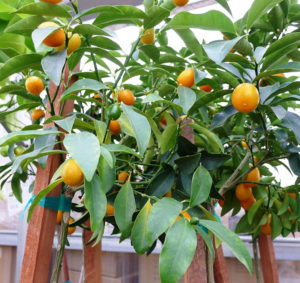 I know a gardener’s real wish for the holidays is for planting time to hurry up and get here. Instead of trying to rush the season, let’s shake off the doldrums by giving (or getting) a dwarf citrus tree for the holidays. It’s like adding a little sunshine to every chilly day.
I know a gardener’s real wish for the holidays is for planting time to hurry up and get here. Instead of trying to rush the season, let’s shake off the doldrums by giving (or getting) a dwarf citrus tree for the holidays. It’s like adding a little sunshine to every chilly day.
An orange, lemon, grapefruit or kumquat tree may be more at home in California landscapes, but as container plants they do just fine in Colorado. Potted citrus trees are a novel holiday gift because they provide many seasons of enjoyment, especially those with fragrant, sweet-scented flowers.
For the best present, select a healthy potted tree, that’s several feet tall. Make sure it’s in a container with good drainage, and be sure to include a saucer large enough to catch any excess water. A thoughtful addition to the gift is a rolling plant stand to make it easier to move.
In fact, moving a citrus tree is part of the fun of growing one. These trees like to spend time outside during warm weather, but need to be moved indoors when the temperatures start to drop in fall. A slow transition from outside to inside and back again helps trees become acclimated to each temporary living space.
Now that winter is near, dwarf citrus trees become extra-special houseplants as they spend the cold months indoors. Trees can do just fine in a cool indoor setting, but they will do best in a sunny, south-facing window.
No sunny spot? No problem. There are plenty of simple supplemental lighting options to ensure the tree gets enough light through winter.
Light is certainly important, however, watering is the most critical aspect of caring for trees – as in don’t overwater! Indoor trees need soil that’s on the drier side to prevent roots from rotting.
Too much water is the number one reason for an indoor container tree’s decline. Because the tree doesn’t use as much water as it would during a hot summer, it simply needs less. The soil has to dry between waterings.
Before watering, wait for signs of wilting, like droopy leaves. Another gardener’s test is to use a short ruler to poke into the soil and measure whether it’s dry to at least 2 inches before giving it a drink.
In addition to root rot, consistently wet soil can encourage other problems, like attracting insect pests.
When gardening indoors with container citrus trees, it’s important to keep an eye out for signs of insect activity. A weekly inspection for small white insects, webbing on branches or brown lumpy areas on leaves is all it takes to spot a potential problem.
Similar to treating some insect pest issues on outdoor plants, a good spray of water may dispatch pests quickly. Some gardeners also add a small amount of alcohol to the water spray and wipe leaves with a soft cloth.
When the nighttime temperatures are consistently warm in spring, move your container tree outside to a sheltered area, like a covered porch or patio, and protect leaves from sunburn.
Spring is also a good time to fertilize with a citrus tree formula or a well-balanced, slow-release plant food.
After the tree flowers, it may take six months or longer for fruits to mature and ripen. Be patient, and you’ll be rewarded with the gift of fresh oranges or lemons to enjoy no matter what the season.


